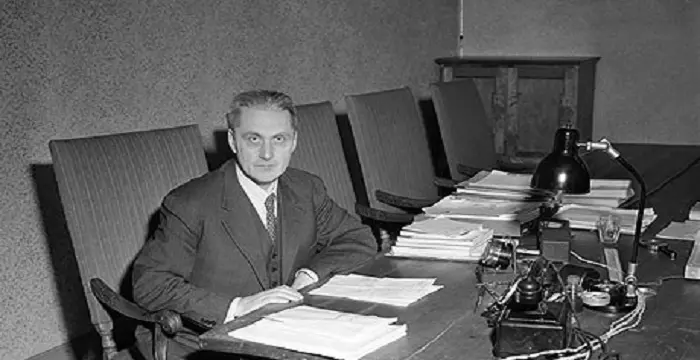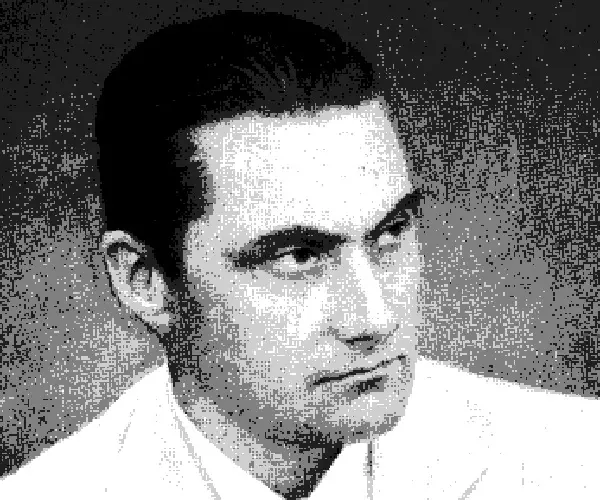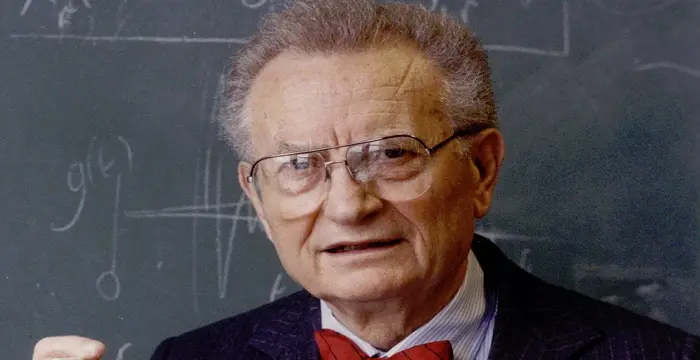
Ragnar Frisch - Norwegian Men, Family and Family
Ragnar Frisch's Personal Details
Ragnar Frisch was a renowned Norwegian economist who founding the discipline of econometrics
| Information | Detail |
|---|---|
| Birthday | March 3, 1895 |
| Died on | January 31, 1973 |
| Nationality | Norwegian |
| Famous | Intellectuals & Academics, Economists, Norwegian Men |
| Spouses | Astrid Johannessen, Marie Smedal |
| Childrens | Ragna |
| Universities |
|
| Birth Place | Oslo |
| Gender | Male |
| Father | Anton Frisch |
| Mother | Ragna Fredrikke Kittilsen |
| Sun Sign | Pisces |
| Born in | Oslo |
| Famous as | Economist |
| Died at Age | 77 |
// Famous Norwegian Men
Herman Tommeraas
Herman Tommeraas is a Norwegian actor and model. Check out this biography to know about his birthday, childhood, family life, achievements and fun facts about him.
Martinus Gunnarsen
Martinus Gunnarsen is a Norwegian singer and the twin brother of Marcus Gunnarsen, better known as M&M. Let’s take a look at his family, personal life, music career, achievements, and some fun facts.
Alan Walker
Alan Walker is a Norwegian-British music producer, and disc jockey. Check out this biography to know about his childhood, family, personal life, career, etc.
Ragnar Frisch's photo
Who is Ragnar Frisch?
Ragnar Frisch was a renowned Norwegian economist, best remembered for founding the discipline of econometrics, which can be described as the branch of economics that aims to give empirical content to economic relations. Being one of the joint winners of the first Nobel Memorial Prize in Economic Sciences in 1969 (with Jan Tinberger), it was also he who coined the widely used term macroeconomics/microeconomics in 1933. Frisch can also be undoubtedly regarded as one of the founding fathers of economics as a modern science. He made several significant advances in the field of economics and his paper in consumer theory written in 1926 helped set up the Neo-Walrasian research. It was also he who helped formalize production theory, which is the study of production, or the economic process of converting inputs to outputs. In 1930, he founded ‘The Econometric Society’, an international society of academic economists wanting to apply statistical tools to their field. There were about 700 Elected Fellows of the Econometric Society as of 2014, which makes it one of the most renowned research affiliations. For more than twenty years, he remained the editor of the journal ‘Econometrica’.
// Famous Intellectuals & Academics
Bertil Gotthard Ohlin
Bertil Gotthard Ohlin was a famous Swedish economist. This biography profiles his childhood, family life & achievements.
Emily Greene Balch
Emily Greene Balch was an American economist, sociologist and pacifist who won the 1946 Nobel Peace Prize. This biography of Emily Greene Balch provides detailed information about her childhood, life, achievements, works & timeline.
Martin Buber
One of the greatest philosophers to have ever walked on earth, Martin Buber contributions to philosophy is a long-standing one. Explore all about his profile, childhood, life and timeline here.
Childhood & Early Life
Ragnar Frisch was born to Anton Frisch and Ragna Frederick Frisch, on 3 March 1895, in Oslo, Norway. His father was a gold and silversmith. His family had emigrated from Germany to the town of Konsberg in Norway in the 17th century itself. Since his ancestors had been working in the silver mines of Konsberg for generations, his grandfather became a goldsmith and continued the legacy, and Ragnar’s father also did the same.
Like his father, Ragnar was also expected to continue the family business, which led him to becoming a trainee in the David Andersen workshop, which was situated in Oslo. However, because of his mother’s insistence, he got admitted at the Royal Frederick University (University of Oslo), while continuing his training as well.
With economics as his main subject, he received his bachelor’s degree in 1919. The following year, he also passed the handicraftsman tests, and started working in his father’s workshop as an associate.
In 1921 Frisch received a fellowship from his university which gave him the opportunity to go to France and England for higher studies. There Frisch spent three years studying economics and mathematics, after which he returned to Norway.
Career
By the time, Ragnar Frisch returned to Norway in 1923, he had realized that economics was his real calling. At that time his family business was having difficulties but Ragnar Frisch was more inclined towards his scientific research.
He published a few papers on probability theory and began teaching at the University of Oslo in 1925. He earned his Ph.D. with a thesis in mathematical statistics the following year. His lectures on production theory were eventually published as a book much later in 1965.
He published his first seminal article in 1926, which was named ‘Sur un problem d’economie pure’. His view was that just like other sciences, economics should follow the same path towards theoretical and empirical quantification. Ecometrics, as Frisch felt, would only help realize that goal. According to him, a better understanding of economics could be gained with the use of mathematical tools.
In 1927, he went to the United States after receiving a scholarship from the Rockefeller Foundation. There he associated with many other economists, like Irving Fisher, Allyn Young, and Henry Schultz. He also wrote a paper where he analyzed the role of investments in explaining economic fluctuations. American economist Wesley Mitchell popularized his paper as he felt that it was introducing new and advanced methods.
His fellowship was extended and although it gave him the opportunity to travel to France and Italy, Ragnar Frisch had to go back to Norway because of his father’s death. He then had to spend one year in modernizing and financing his family business, as well as looking for someone to manage the business on his behalf.
After that he resumed his academic career and very soon, in 1928, got appointed as an Associate Professor of Statistics and Economics at the University of Oslo itself. After publishing several articles on statistics as well as economic metrology, and introducing dynamics in economic analysis, Frisch became a full Professor in the University in 1931.
Over the years he became well-known mainly for the development of large-scale econometric modeling linked to both economic planning as well as national income accounting. Including the trade cycle production theory and statistical theory, Frisch was involved with a wide range of macroeconomic topics.
Ragnar Frisch firmly believed that economics can help solve the problems people face in society. However, the devastation caused by the World War II and the Great Depression greatly influenced him and he arrived at the conclusion that economics and politics alone can never solve the problems that the world is suffering from. He argued that social transformation was necessary as well. However, because of misinterpretation of his statement by others, he was forced to withdraw his opinion.
In his later years, Frisch also worked as an advisor to the government on issues related to economics and planning, though he was never given an official position. Many of his economic tools and methods were of great use to the Norwegian government.
Major Works
Along with Frederick Waugh, he introduced the famous Frisch-Waugh theorem. According to this theorem, in a standard regression model, the determination of the coefficients via ordinary least squares is equivalent to a method involving projection matrices.
Ragnar Frisch penned numerous important articles in his lifetime, some of which were ‘The Relationship between Primary Investment and Reinvestment’ (1927), ‘Theory of Production’ (1965), and ‘Econometrics in the World of Today’ (1970).
Awards & Achievements
Ragnar Frisch, along with Dutch economist Jan Tinbergen, was jointly awarded the first Nobel Memorial Prize for Economic Sciences in 1969, for developing as well as applying dynamic models for the analysis of economic processes.
Personal Life & Legacy
Ragnar Frisch married Marie Smedal in 1920 and had a daughter named Ragna. After Marie’s death in 1952, he got remarried to his childhood friend Astrid Johannsen. This marriage lasted till his death.
He passed away on January 31, 1973, in Oslo, Norway.
The Frisch Medal, named after him, is awarded every two years by ‘The Econometric Society’, for exceptional empirical or theoretical research work published in the magazine ‘Econometrica’ during the past five years. It is considered as one of the top three prizes in the field of economics.
// Famous Economists
Bertil Gotthard Ohlin
Bertil Gotthard Ohlin was a famous Swedish economist. This biography profiles his childhood, family life & achievements.
Emily Greene Balch
Emily Greene Balch was an American economist, sociologist and pacifist who won the 1946 Nobel Peace Prize. This biography of Emily Greene Balch provides detailed information about her childhood, life, achievements, works & timeline.
Paul Samuelson
Nobel laureate Paul Anthony Samuelson is referred to as the ‘Father of Modern Economics’. This biography profiles his childhood, life, career, achievements and interesting facts about him.
Ragnar Frisch biography timelines
- // 3rd Mar 1895Ragnar Frisch was born to Anton Frisch and Ragna Frederick Frisch, on 3 March 1895, in Oslo, Norway. His father was a gold and silversmith. His family had emigrated from Germany to the town of Konsberg in Norway in the 17th century itself. Since his ancestors had been working in the silver mines of Konsberg for generations, his grandfather became a goldsmith and continued the legacy, and Ragnar’s father also did the same.
- // 1919With economics as his main subject, he received his bachelor’s degree in 1919. The following year, he also passed the handicraftsman tests, and started working in his father’s workshop as an associate.
- // 1920 To 1952Ragnar Frisch married Marie Smedal in 1920 and had a daughter named Ragna. After Marie’s death in 1952, he got remarried to his childhood friend Astrid Johannsen. This marriage lasted till his death.
- // 1921In 1921 Frisch received a fellowship from his university which gave him the opportunity to go to France and England for higher studies. There Frisch spent three years studying economics and mathematics, after which he returned to Norway.
- // 1923By the time, Ragnar Frisch returned to Norway in 1923, he had realized that economics was his real calling. At that time his family business was having difficulties but Ragnar Frisch was more inclined towards his scientific research.
- // 1925He published a few papers on probability theory and began teaching at the University of Oslo in 1925. He earned his Ph.D. with a thesis in mathematical statistics the following year. His lectures on production theory were eventually published as a book much later in 1965.
- // 1927In 1927, he went to the United States after receiving a scholarship from the Rockefeller Foundation. There he associated with many other economists, like Irving Fisher, Allyn Young, and Henry Schultz. He also wrote a paper where he analyzed the role of investments in explaining economic fluctuations. American economist Wesley Mitchell popularized his paper as he felt that it was introducing new and advanced methods.
- // 1928After that he resumed his academic career and very soon, in 1928, got appointed as an Associate Professor of Statistics and Economics at the University of Oslo itself. After publishing several articles on statistics as well as economic metrology, and introducing dynamics in economic analysis, Frisch became a full Professor in the University in 1931.
- // 1969Ragnar Frisch, along with Dutch economist Jan Tinbergen, was jointly awarded the first Nobel Memorial Prize for Economic Sciences in 1969, for developing as well as applying dynamic models for the analysis of economic processes.
- // 31st Jan 1973He passed away on January 31, 1973, in Oslo, Norway.
// Famous Pisces Celebrities peoples
Christine Baumgartner
Christine Baumgartner is an American model and the wife of famous American actor Kevin Costner. Check out this biography to know about her birthday, childhood, family life, achievements and fun facts about her.
Galina Becker
Galina Becker is a former athlete and fitness model from America. Check out this biography to know about her birthday, childhood, family life, achievements and fun facts about her.
Nikkie De Jager
Check out all that you wanted to know about Nikkie De Jager, the famous Dutch Makeup artist; her birthday, her family and personal life, her boyfriends, fun trivia facts and more.
Annie Bakes
Annie Bakes is an American adult model and the ex-wife of Dennis Rodman. Check out this biography to know about her birthday, childhood, family life, achievements and fun facts about her.
Jordyn Jones
Jordyn Jones is an American dancer. Let’s have a look at her family & personal life including age, date of birth, boyfriends, net worth, and fun facts.
Oscar Rosenstroem
Oscar Rosenstroem is a Danish Musical.ly star. Let’s have a look at his family and personal life including age, date of birth, girlfriends, net worth and fun facts.
Ragnar Frisch's FAQ
What is Ragnar Frisch birthday?
Ragnar Frisch was born at 1895-03-03
When was Ragnar Frisch died?
Ragnar Frisch was died at 1973-01-31
Where was Ragnar Frisch died?
Ragnar Frisch was died in Oslo
Which age was Ragnar Frisch died?
Ragnar Frisch was died at age 77
Where is Ragnar Frisch's birth place?
Ragnar Frisch was born in Oslo
What is Ragnar Frisch nationalities?
Ragnar Frisch's nationalities is Norwegian
Who is Ragnar Frisch spouses?
Ragnar Frisch's spouses is Astrid Johannessen, Marie Smedal
Who is Ragnar Frisch childrens?
Ragnar Frisch's childrens is Ragna
What was Ragnar Frisch universities?
Ragnar Frisch studied at University of Oslo
Who is Ragnar Frisch's father?
Ragnar Frisch's father is Anton Frisch
Who is Ragnar Frisch's mother?
Ragnar Frisch's mother is Ragna Fredrikke Kittilsen
What is Ragnar Frisch's sun sign?
Ragnar Frisch is Pisces
How famous is Ragnar Frisch?
Ragnar Frisch is famouse as Economist













